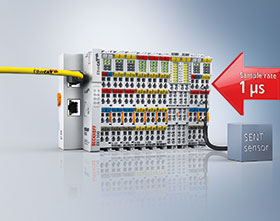

Digital sensors return a discrete value of 0 or 1 to a controller. The controller, usually connected to I/O systems over a fieldbus, reads out the bus system data in a set cycle, commonly clocked in the millisecond range. Important to note here is that the bus system needs a degree of determinism and the controller must run in synchronisation with it, even if bus cycles are sometimes longer or shorter. With Beckhoff hardware and software, the synchronisation between controller and bus system are assured, as are the deterministic features of the ultra-fast EtherCAT communication system. This means that PC-based control provides the ideal foundation on which to implement oversampling technology.
Bus cycle subdivision with oversampling
Oversampling involves polling signals at a configurable multiple of the bus cycle time (i.e. in micro cycles) and writing the results to a temporary buffer. The set of process data collected is then transferred during the next bus cycle. Oversampling functionality can avoid situations like the following during signal polling: If, for example, a sensor is queried every 10 ms, only the data available at the precise time of the query is actually acquired. The controller is effectively blind from one query to the next, so details of any changes in the sensor’s state occurring between PLC queries are not recorded. For instance, a sensor’s state might switch from 0 to 1 and stay there for 9.9 ms. If it then reverts to 0, the sensor signal – from the perspective of the controller reading it out – will appear not to have changed at all over the 10 ms cycle.
Situations like this can be detected by using an EtherCAT oversampling input terminal such as the EL1262 to connect the sensor. This terminal is able to subdivide the bus cycle into as many as 1000 micro cycles. In the case of a 10 ms bus cycle, an oversampling factor of 1000 translates into a sampling interval of 10 µs. In a 1 ms bus cycle, a sampling interval of just 1 μs can be achieved, which is the shortest that EtherCAT oversampling terminals can currently support. This technology is ideal for reading out SENT sensors.
The pulse width encoding protocol: SENT
Single Edge Nibble Transmission (SENT) is a simple, unidirectional, asynchronous protocol that encodes sensor data based on the time between falling edges in a digital signal.
The pulse length describes the signal value transmitted. A single bit in the SENT protocol generally corresponds to 3 μs, which meets the minimum requirement in terms of sampling precision. The signal level is 5 V. The EL1262-0050 oversampling terminal meets both requirements in that it supports precise data acquisition down to 1 μs and is capable of processing the signal level directly. It can sample each bit of the SENT signal three times – more than enough to read the data transmitted in a signal pulse.
The data sets acquired are then processed in a ready-made function block, which evaluates the pulse lengths recorded, calculates the checksums and then marks the value either as valid or invalid.
The SENT protocol is mainly used for communication between sensors and electronic control units in vehicle electronics. Due to the simplicity of the protocol, the microcontrollers in ECUs are capable of evaluating it. SENT protocol receivers are not available for use in constructing measurement and test benches, but the open Beckhoff control system offers an alternative: The EL9505 power supply terminal can serve as the required 5 V power source, and the EL1262-0050 variant of the EtherCAT digital input terminal can be used to capture the sensor signal. In this way, SENT sensors can be directly and easily connected to the open and modular control platform from Beckhoff. This means that test benches equipped with Beckhoff technology can be used to conduct quality inspections on, say, throttle valve or steering torque sensors and make any necessary adjustments before the sensors are fitted to a vehicle.
| Tel: | +27 11 795 2898 |
| Fax: | 086 603 6868 |
| Email: | info@beckhoff.co.za |
| www: | www.beckhoff.com |
| Articles: | More information and articles about Beckhoff Automation |
© Technews Publishing (Pty) Ltd | All Rights Reserved